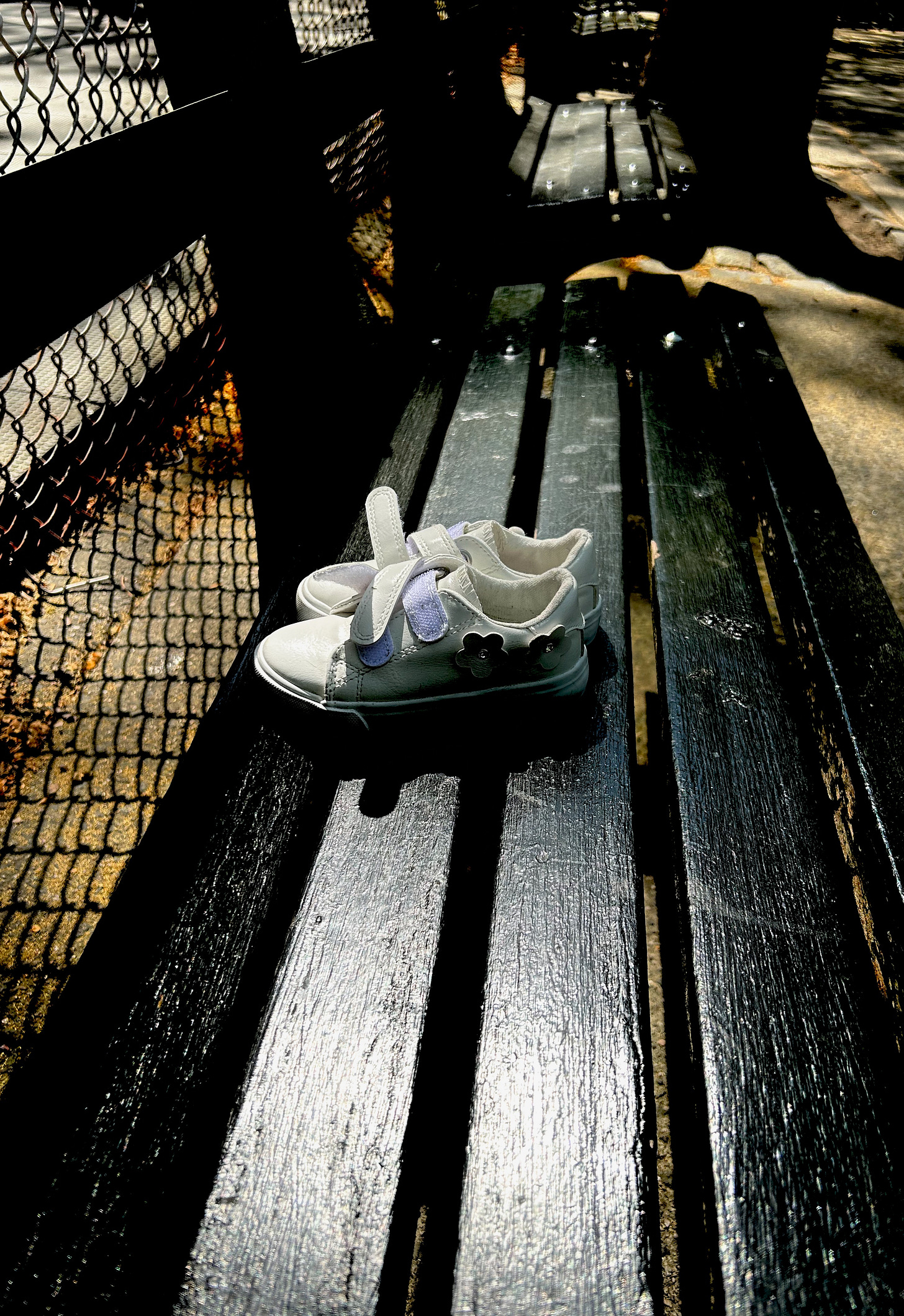There is something “girly” about the shoes I thought, slightly alarmed at my instant stereotype, I who have taken a stand on upending stereotypes. Am I biased or are the shoes biased?
Whose shoes these are I do not know, they are pure, lovely and aglow. They sat side by side, in pristine whiteness and newness on a park bench in the Camel Park on Dekalb in Brooklyn. It was as if someone had lovingly put them up there so as to not soil them or leave them behind. I waited for a mother, I am not being sexist, there were no men, to come rushing over to claim them, nobody approached the bench as the wind stirred and the shadows struggled to grow longer, unsure if it was time to depart as the clouds remained resolutely disorderly.
I tried to get the 5-year-old girl and 7-year-old boy I was shepherding to play a guessing game and asked “Whose shoes do you think these are?” They shrugged with total indifference, she ran back to the swings and he dribbled a stray basketball. Without playmates I decided to play a detective game ‘Whose shoes’ by myself. My first answer was instantaneous, a girl’s shoes. How did I know and how was I so sure?
My instant stereotype, a girls’ shoes are girly. There was something delicate about them. Second stereotype. They had girly decorations. There were two discs on the outer sides of the ankles. As I looked closer I saw they were flowers. The flowers had not registered consciously but they must have registered at some level in my mind’s classification system that is programmed to slot information into categories to make sense of images and experiences. As I stepped closer to examine them, the shoe corporation had helpfully written on the gleaming white sole inside the shoe, “girls” in a flowery script, to make sure that buyers don’t make gender identity mistakes. In other words, boys don’t buy if you want to be considered a boy. Finally, my stereotype classification was still a binary.
Children’s clothing in the western world was the same for girls and boys till the 1950’s. It is only when corporations realized that they could double their profits by gendering clothes, shoes and how girls and boys were supposed to express their proper gender identities did baby girls and baby boys clothing develop completely different tracks with pink for girls and blue for boys.
I travel constantly from New York, to Seattle, to Vancouver to London to Dublin to Nairobi to New Delhi and Singapore. Given a clutch of nieces and nephews and their children, I try to go to a children’s clothing or toy store to capture cultural expression through local gifts. And I deliberately specify only the age of the child. In every country, the first question I get asked by the sales person, usually a woman, is, yes, you guessed it, “Girl or Boy”? And every time I say it doesn’t matter and the response is, “Ma’m, we have different sections for girls and boys.
Given the deep societal encoding of the girl boy binary despite what children experience at home and despite countries encoding equality across genders in their constitutions (the US is an exception), it is up to us not only to fight for right policies but to be vigilant every moment of our own biases. Putting bits of information into categories serves an important brain function to manage billions of bits of information to inform quick decision making, for example the brain quickly distinguishes between a chair and table, based on experience and this helps us make sense of our environment. But if each time we encountered a chair, and we had to slow down to figure out if a chair is really a chair, or a road is really a road or is it the milky way across the skies, we wouldn’t be able to function.
But there is another way of thinking, by slowing down and making a conscious deliberate decision, as Nobel Peace prize economist Daniel Kanneman implores us to distinguish between quick and slow thinking. This is also why mindfulness training is helpful in overcoming bias. It helps us slow down the automatic reactions of the old brain and the quick brain. As does counting to 3 or 5 before making a decision.
We live in a multicultural society. Rather than pretending we are not gender biased, be vigilant of yourself, your own family, your own work environment and talk about what you are doing to overcome biases of gender and race, caste and class, it’s all interconnected. And when you fail, notice and return to your commitment, after repairing harm.
That is an act of courage.
We absorb biases despite good intentions by just being alive and breathing in society. Those white shoes belonged to a little white girl brought to the park by a black Nanny. In Brooklyn, the Utopia of white liberals.
I can breathe my biases out.


